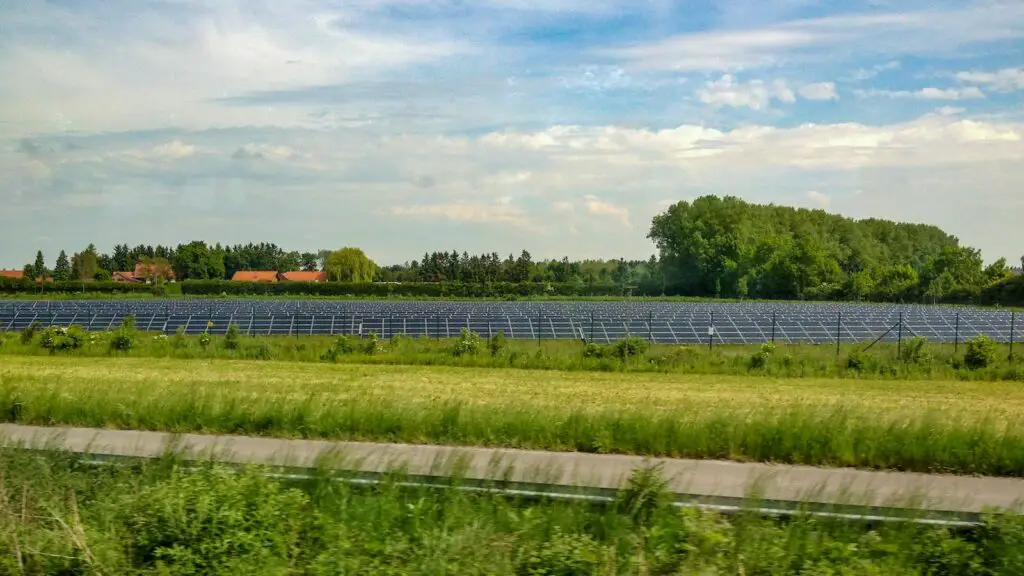The history of solar energy dates back to 1839, when Edmond Becquerel (French physicist) discovered the photovoltaic effect.
However, the development of solar farms didn’t start until the latter half of the 20th century.
In 1982, Arco Solar’s 1 MW Lugo plant in Hesperia, California, was a turning point in the history of solar energy.
This ground-breaking project was the first utility-scale solar energy generation plant, consisting of over 100,000 photovoltaic modules spread across 20 acres, making it the largest solar power plant.
This success of Lugo Solar Power brought attention to the potential of solar energy as a viable alternative energy source, leading to increased investment in research and development.
In 2004, Germany’s feed-in tariffs sparked growth in solar park development and the construction of several hundred solar facilities with capacities exceeding 1 MW.
Spain soon became a leader in the solar park market due to its feed-in tariff system, resulting in the construction of over 60 solar parks with capacities of over 10 MW.
However, changes to these incentives later impacted the growth of the industry.
Nevertheless, the advancements in feed-in tariffs in countries like Germany and Spain have played a crucial role in promoting the development and expansion of the solar energy industry.
Since the rise of solar farms, the solar energy industry has undergone tremendous growth and innovation.
Improvements in photovoltaic technology have led to higher efficiency and lower costs, making solar more accessible to consumers and businesses globally.
Today, solar farms play a crucial role in global renewable energy efforts and are a step towards a cleaner and more sustainable future.
Largest Solar Power Plants In The World
Bhadla Solar Park, India (2,245 MW)
Located in the sun-drenched state of Rajasthan, India, Bhadla Solar Park is one of the world’s largest solar power plants.
Spread across 14,000 acres, the facility boasts a total installed capacity of 2,245 MW. The solar farm is home to multiple PV power plants owned and operated by various public and private entities.
The massive facility plays a critical role in India’s ambitious target of achieving 175 GW of renewable energy capacity by 2022 and helps to reduce the country’s dependence on fossil fuels.
Pavagada Solar Park, India (2,050 MW)
Situated in the southern state of Karnataka, India, the Pavagada Solar Park is another giant solar power plant.
Covering an area of approximately 13,000 acres, the facility has a total installed capacity of 2,050 MW.
The Solar farm consists of several individual PV power plants developed by public and private entities.
The Pavagada Solar Park helps India progress towards its renewable energy goals and contributes to the country’s efforts in reducing greenhouse gas emissions.
Benban Solar Park, Egypt (1,650 MW)
The Benban Solar Park, located near Aswan, Egypt, is a massive solar power plant covering approximately 14.4 square miles.
With a total installed capacity of 1,650 MW, the facility comprises over 30 individual PV power plants.
The Solar farm plays a significant role in Egypt’s strategy to generate 20% of its electricity from renewable sources by 2022.
It also supports the country’s goal of reducing carbon emissions by 2030, in line with the Paris Agreement on climate change.
Tengger Desert Solar Park, China (1,547 MW)
Known as the “Great Wall of Solar,” the Tengger Desert Solar Park is located in the Zhongwei region of China’s Ningxia province.
The facility covers an area of approximately 43 square miles and features a total installed capacity of 1,547 MW.
The Solar farm consists of multiple PV power stations and is a testament to China’s commitment to renewable energy.
The plant plays a crucial role in helping China reduce its carbon emissions and achieve its goal of sourcing 20% of its power from renewable sources by 2030.
Villanueva Solar Park, Mexico (828 MW)
The Villanueva Solar Park, located in Coahuila, Mexico, is one of the largest solar power plants in the world.
Spanning over 9,000 acres, the facility has a total installed capacity of 828 MW.
The Solar farm comprises two PV power plants, Villanueva I, and Villanueva II, which generate enough electricity to power around 1.3 million Mexican households together.
The Villanueva Solar Park is part of Mexico’s commitment to producing 35% of its energy from renewable sources by 2024 and helps the country reduce its reliance on fossil fuels.
Noor Complex Solar Power Plant, Morocco (580 MW)
Located in the Moroccan desert near the city of Ouarzazate, the Noor Complex is one of the largest solar power plants in the world. Spread across an area of 6,000 acres, the facility consists of three separate plants: Noor I, II, and III.
These plants use concentrating solar power (CSP) technology and photovoltaic (PV) panels.
With a total capacity of 580 MW, the Noor Complex provides clean energy to more than 1 million households in Morocco and helps the country achieve its goal of sourcing 52% of its electricity from renewable sources by 2030.
Where Is The World’s Oldest Solar Farm?
The world’s oldest solar power plant is the Solar Energy Generating Systems (SEGS) thermal power facility in California, which has a remarkable capacity of 354 megawatts (MW).
As a testament to the advancements in solar energy, another significant solar power project can be found in the Mojave Desert.
Known as the Ivanpah Solar Electric Generating System, this solar thermal power plant is 40 miles (64 km) southwest of Las Vegas and boasts an impressive gross capacity of 392 MW.
These ground-breaking facilities exemplify solar energy’s evolution and potential in modern times.
Who Is The Father Of Solar Energy?
Often referred to as the “father of solar energy,” Edmond Becquerel made a ground-breaking discovery in 1839 that set the stage for the development of solar power technology.
At the age of 19, Becquerel uncovered the photovoltaic effect, which occurs when specific materials produce an electric current upon exposure to sunlight.
This remarkable discovery laid the foundation for harnessing solar energy and has since led to numerous innovations and advancements in the renewable energy sector.








